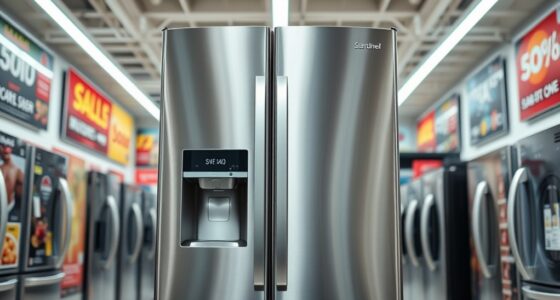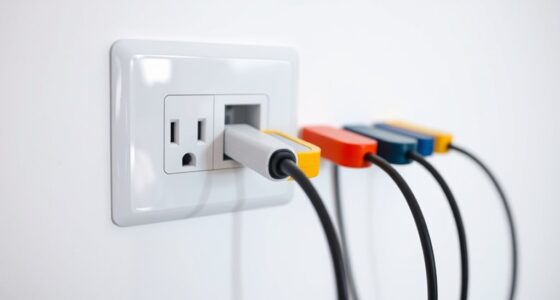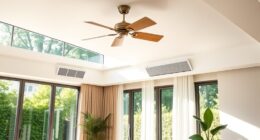When choosing a vacuum, focus on suction power and airflow to guarantee thorough cleaning, and opt for a high-quality filtration system like HEPA filters to trap allergens. Consider the vacuum’s weight and maneuverability for easier operation, and choose quieter models to minimize disruption. Versatile attachments make cleaning tougher spots easier, while durable components ensure long-term use. Plus, easy maintenance keeps your vacuum performing its best. Keep exploring to discover even more tips for finding the perfect vacuum.
Key Takeaways
- Ensure the vacuum has strong suction and efficient airflow to effectively remove dirt and allergens.
- Check for lightweight design and quiet operation for easier maneuverability and less noise disturbance.
- Look for versatile attachments and durable construction to handle various surfaces and extend product lifespan.
- Prioritize easy maintenance features like tool-free filter replacements and accessible compartments.
- Consider battery life and overall durability to guarantee consistent performance and long-term use.
Suction Power and Airflow Efficiency

To get the most effective cleaning, you need a vacuum cleaner with strong suction power and efficient airflow. This ensures dirt and debris are lifted easily from carpets and hard floors. A powerful motor provides the necessary suction, but airflow efficiency keeps debris moving smoothly through the system. If you value cordless convenience, choose a model with good battery life, so you don’t have to stop cleaning mid-job. Longer-lasting batteries let you clean larger areas without recharging, maintaining consistent suction throughout. Keep in mind, higher battery capacity often correlates with better airflow management, preventing loss of power during extended use. Investing in a vacuum with robust suction and reliable battery life guarantees thorough cleaning without interruptions. Additionally, understanding Kia Tuning can inspire innovative upgrades for vehicle enthusiasts seeking performance enhancements.
Filtration System Quality
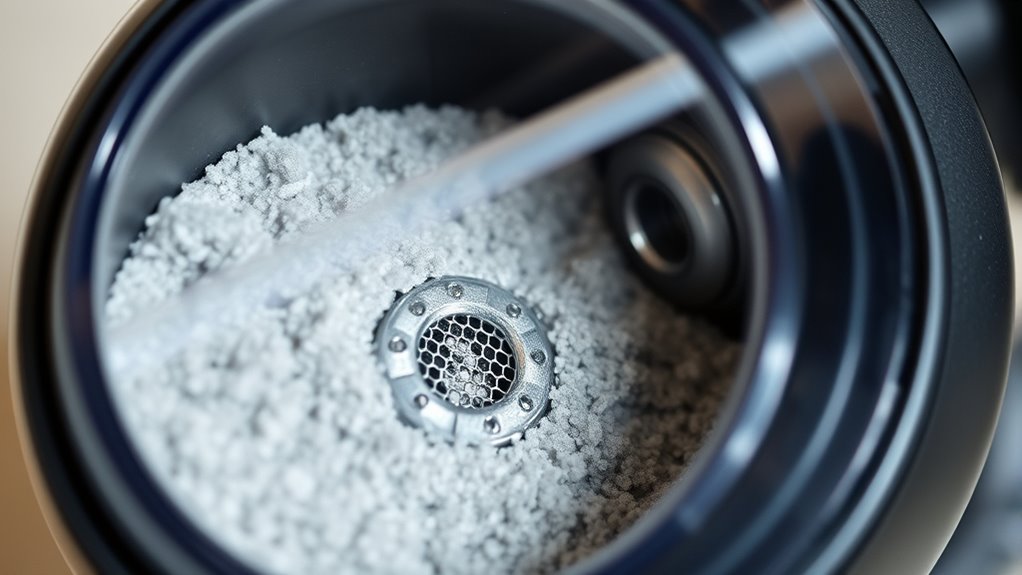
A high-quality filtration system guarantees that the air expelled from your vacuum is clean and free of allergens. HEPA filters are essential because they trap tiny particles, including pollen, dust mites, and pet dander, which can trigger allergy symptoms. When choosing a vacuum, look for models with HEPA filtration to ensure allergy prevention and improve indoor air quality. A good filtration system not only captures debris but also prevents it from recirculating into the air you breathe. Regular maintenance, such as filter replacement, is crucial to sustain its effectiveness. Investing in a vacuum with a superior filtration system helps create a healthier environment, especially if you or someone in your household suffers from allergies or asthma.
Weight and Maneuverability

A lightweight vacuum makes cleaning less tiring and more efficient. Look for models with easy navigation features to move smoothly around furniture and tight spaces. Choosing a design that’s simple to handle can save you time and effort during your cleaning routine. Additionally, opting for a vacuum with organic and natural juice features can improve air quality by reducing dust and allergens released during cleaning.
Lightweight Design Ease
Because a lightweight vacuum cleaner is easier to maneuver, it reduces fatigue during cleaning sessions and makes it simpler to reach tight spaces or high areas. This portability enhances your cleaning efficiency, especially when tackling stairs or awkward corners. A cordless convenience feature further lightens your load, eliminating the hassle of cords and making movement seamless. An ergonomic grip ensures comfort during extended use, reducing strain on your hand and wrist. When choosing a lightweight design, look for models that balance weight with durability and power. Additionally, selecting a vacuum with lightweight construction can improve overall handling and reduce user fatigue during prolonged cleaning tasks. A well-designed, lightweight vacuum helps you clean longer without tiring, allowing you to focus on thorough, effective cleaning rather than battling cumbersome equipment. Overall, a lightweight vacuum boosts your ease and effectiveness in every cleaning session.
Easy Navigation Features
Efficient navigation is essential for making your cleaning routine smoother, especially when dealing with complex layouts or cluttered spaces. A vacuum with cordless convenience lets you move freely without being tethered to a cord, making it easier to reach tight corners and stairs. Look for models with an ergonomic handle that reduces strain on your hand and wrist, allowing for comfortable, extended use. Good maneuverability means the vacuum easily glides around furniture and obstacles without requiring extra effort. Lightweight designs also contribute to easy navigation, so you can carry or push the vacuum effortlessly. Combining cordless convenience, an ergonomic handle, and a lightweight build ensures that your vacuum is easy to steer, helping you clean more efficiently and comfortably. Additionally, choosing a model with advanced sensors can further enhance navigation accuracy and obstacle avoidance.
Noise Levels During Operation
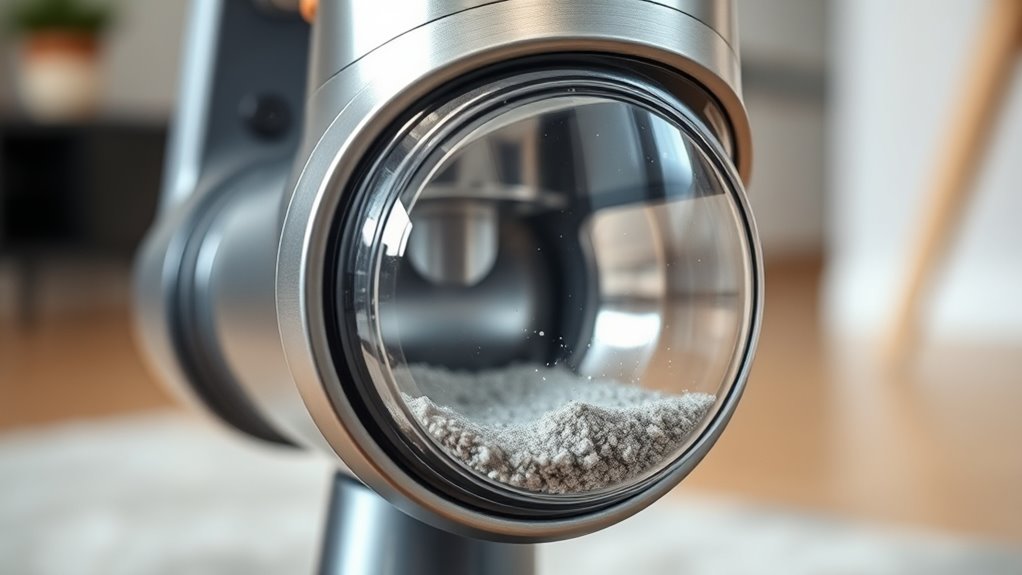
Decibel ratings tell you how loud a vacuum really is, so pay attention before purchasing. A quieter model can make cleaning less disruptive, especially in shared spaces. Using the quiet mode feature can help you get the job done without disturbing others. Additionally, choosing a vacuum with a professional voiceover can provide clearer instructions and improve user experience during operation.
Decibel Ratings Matter
While choosing a vacuum cleaner, paying attention to decibel ratings is essential, as noise levels can considerably impact your experience. A loud vacuum can be disruptive, especially in shared spaces or during late-night cleaning. Lower decibel ratings mean quieter operation, letting you clean without disturbing others. If you value cordless convenience, a quieter vacuum allows more comfortable use without ear fatigue. Keep in mind that a vacuum’s cord length can also influence noise levels; longer cords often mean more powerful motors and louder sounds. To make an informed choice, consider these factors:
- Decibel ratings for quieter operation
- Cordless convenience for mobility
- Cord length affecting power and noise
- Balance between noise levels and suction power
- Air purifier features and technology can also affect overall indoor comfort and noise levels.
Quiet Mode Benefits
Have you ever wished you could clean without disturbing others or adding to the noise pollution? Quiet mode benefits make this possible by appreciably lowering noise levels during operation. This feature is perfect for early mornings, late nights, or homes with pets and children. With quiet mode, you can enjoy cordless convenience without sacrificing peace and quiet. Plus, many models optimize battery longevity by reducing power in this mode, allowing you to clean longer without draining the battery quickly. This means you get efficient cleaning while maintaining a peaceful environment. Overall, quiet mode enhances your vacuuming experience by balancing performance with noise control, making it an essential feature for anyone who values tranquility during household chores. Additionally, sound healing science suggests that reducing noise exposure can positively impact your mental well-being.
Versatility of Attachments and Tools
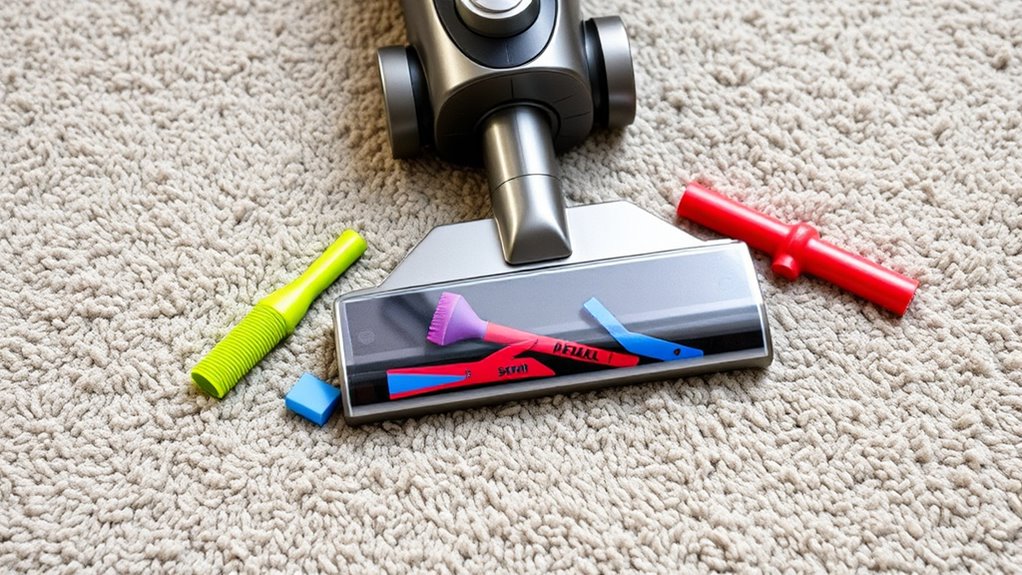
Attachments and tools considerably enhance your vacuum cleaner’s versatility, allowing you to tackle various surfaces and hard-to-reach areas with ease. Good attachments versatility means you can switch between cleaning floors, upholstery, and tight corners effortlessly. Guarantee your vacuum offers excellent tool compatibility to expand its functionality. Look for accessories like crevice tools for narrow gaps, upholstery brushes for furniture, dusting tools for delicate surfaces, and motorized brushes for carpets. These attachments help you customize your cleaning experience, making it more efficient and thorough. By selecting a vacuum with a wide range of compatible tools, you’ll save time and effort, preventing the need for multiple devices. The right set of attachments truly maximizes your vacuum’s potential and simplifies your cleaning routine.
Durability of Components and Build
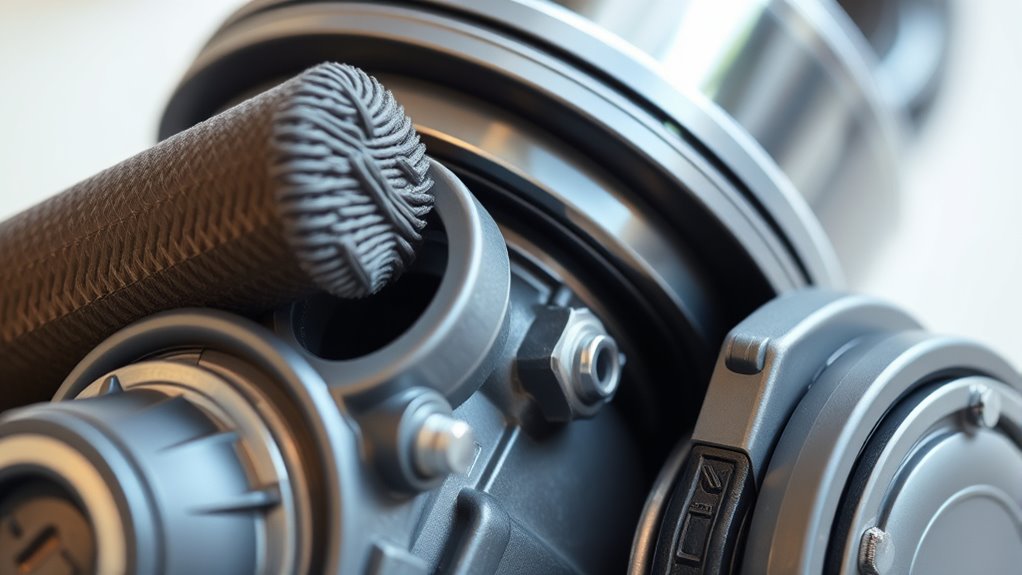
Choosing a vacuum with resilient components and a solid build guarantees it will withstand frequent use and last for years. Look for sturdy materials like reinforced plastics and metal parts, especially in high-stress areas. This ensures your vacuum remains reliable, even with daily chores. If you opt for cordless convenience, check that the battery life is sufficient for your needs; a well-built model maintains performance over time. To understand the importance of durability, consider this:
| Material | Longevity | Impact on Use |
|---|---|---|
| Reinforced Plastic | High | Resists cracking |
| Metal Components | Very high | Adds stability |
| Battery Cells | Moderate to high | Affects runtime |
| Seals & Gaskets | Long-lasting | Prevents leaks |
| Handle & Housing | Durable | Ensures comfort |
Durability saves you money and frustration in the long run. Additionally, manufacturers’ quality standards often influence the overall durability and performance of vacuum cleaners.
Ease of Maintenance and Filter Replacement

Maintaining your vacuum and replacing filters shouldn’t feel like a chore; in fact, the easier these tasks are, the more likely you are to keep up with them regularly. Good maintenance ease ensures your vacuum performs at its best and lasts longer. When choosing a model, look for features like tool-free filter replacement or accessible filter compartments. Regular filter replacement prevents clogging and maintains suction power. Consider vacuums with washable filters to save money and reduce waste. Also, check if the vacuum has clear indicator lights for maintenance alerts. Ease of maintenance directly influences how often you’ll perform necessary upkeep, preserving performance and extending lifespan. Additionally, selecting a vacuum with features similar to all-waterparks ensures a comprehensive and enjoyable cleaning experience. Prioritizing these features helps you avoid neglecting filter replacement and keeps your cleaning routine smooth and efficient.
Frequently Asked Questions
How Does Vacuum Size Affect Storage and Portability?
Vacuum size directly impacts storage capacity and portability benefits. A larger vacuum offers more storage capacity, meaning you can clean longer without emptying it often. However, bigger models tend to be heavier and bulkier, making them less portable. Smaller vacuums are lightweight and easier to carry or store in tight spaces, enhancing portability benefits. Consider your storage space and cleaning needs to choose a size that balances capacity with ease of movement.
Are Cordless Vacuums as Powerful as Corded Models?
They say “good things come in small packages,” and that’s true for cordless vacuums. While they’re convenient and easy to maneuver, their power varies. You need to contemplate battery life and charging time, which can impact performance. Modern models often match corded vacuums in suction power, but always check reviews. If your space needs quick cleans, a cordless can be just as effective—just keep an eye on battery endurance.
What Safety Features Should I Consider in a Vacuum Cleaner?
When choosing a vacuum cleaner, safety features are essential. Look for a safety lock to prevent accidental activation, especially around children. A child lock is also important to keep little ones from tampering with settings or opening compartments. These features help keep your home safe while maintaining effective cleaning. Prioritizing safety locks and child locks guarantees you enjoy peace of mind during everyday use.
How Long Do Vacuum Filters Typically Last?
How long your vacuum filter lasts depends on usage, environment, and filter type. Typically, filters need replacement every 3 to 6 months, but high-traffic homes or allergies might shorten that lifespan. Keep an eye on filter lifespan to maintain peak performance and avoid costly repairs. Regular replacement reduces filter replacement cost, prolongs vacuum life, and ensures cleaner air. Stay proactive, check your filters often, and replace them when needed.
Do Vacuum Cleaners With HEPA Filters Improve Allergy Relief?
Yes, vacuum cleaners with HEPA filtration considerably improve allergy relief. HEPA filters trap tiny particles like pollen, pet dander, and dust mites, enhancing allergen removal. When you use a HEPA-equipped vacuum, you’re reducing airborne allergens and creating a healthier environment. This is especially beneficial if you or someone in your home suffers from allergies or asthma, as it helps keep indoor air cleaner and easier to breathe.
Conclusion
When choosing a vacuum, remember these seven factors to guarantee you get the best clean. Don’t just settle for style—think about suction, filtration, and how easy it is to maneuver. A good vacuum should be as reliable as your trusty horse and as quiet as a library. By considering these details, you’ll find one that fits your needs perfectly and keeps your home spotless without any fuss or bother.



